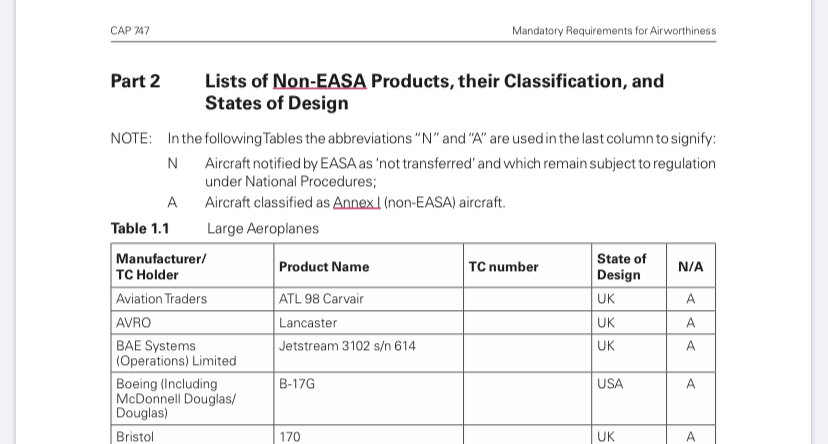Airborne_Again wrote:
Really, I never cease to be surprised that some people are so convinced that EASA is evil that they grasp at every straw that seems to support their conviction.
Fully agree – but sometimes it’s simply due to a lack of understanding that EU is something completely different than USA and therefore the relationship between the EASA and the independent CAAs in the member states is a quite complex one.
Too many people outside the EU (and some inside) still believe that EASA is something like FAA and the national CAAs are something like FSDOs…
Silvaire wrote:
For reference, FAA practice for foreign certified aircraft is dependent on the treaty status between the foreign certifying nation and the USA. If a treaty exists, the aircraft type can be given an FAA type certificate on the basis of the foreign TC.
So what’s in your opinion the difference to Europe?
I probably should have just posted the original document.

The EASA activity is ridiculous, but It’s equally hilarious that UK CAA catalogs aircraft designs with which they have had no involvement whatsoever including listing in some cases the US or other foreign TC number with which they have no involvement or authority. The whole thing is just silly.
For reference, FAA practice for foreign certified aircraft is dependent on the treaty status between the foreign certifying nation and the USA. If a treaty exists, the aircraft type can be given an FAA type certificate on the basis of the foreign TC. The type is then actively managed by FAA within US law, meaning for example that foreign nation ADs are collected, reviewed and potentially enhanced or modified to eliminate illegal ‘business development’ practices originating in countries where ADs are mostly the product of the aircraft manufacturer with little oversight. A disciplined process exists for public comment by US owners of the type by US regulators with power over their aircraft. If an applicable international treaty does not exist, the aircraft can be operated in the US within Experimental Category, generally without reference to foreign government actions. There is a marked contrast between the legal and technical discipline of the FAA approach and what is shown here. The FAA earns its living doing something beyond extending childhood interest in plane spotting to collecting a paycheck.
Silvaire wrote:
I cut and pasted the text above directly from the link, top of page 31.
Indeed, and you
1) omitted the “also includes” part
2) gave the impression that the whole list was the EASA list when actually only 14 out of the 5-600 aircraft types (the ones marked “N”) were from EASA’s list.
Silvaire wrote:
In the following Tables the abbreviations “N” and “A” are used in the last column to signify:N Aircraft notified by EASA as ‘not transferred’ and which remain subject to regulation under National Procedures;
A Aircraft classified as Annex I (non-EASA) aircraft.
I cut and pasted the text above directly from the link, top of page 31.
Happily, the chance of me ever having any interaction with EASA or its subordinates for any reason is precisely zero, and with good reason. Whether anybody else would be unconcerned by being subjected to their worldview is equally happily of no concern to me.
Silvaire wrote:
The UK CAA link provided by Peter includes “Aircraft notified by EASA as ‘not transferred’ and which remain subject to regulation under National Procedures”The paradigm of cataloging aircraft types not certified by European countries is creepy. There is regardless no way I’d ever enter into any relationship via licensing or aircraft at ownership with EASA or one of it its captive national CAAs.
That’s not at all what the document says. The full passage you are quoting from reads:
“The list of aircraft given in Section 1, Part 2 of this CAP 747 shows aircraft types on the UK register in these last three categories and which have therefore been designated as “non-EASA aircraft”. The list also includes aircraft notified by EASA as “not transferred” and which remain subject to regulation under National Procedures.” (My emphasis.)
The list includes 14 aircraft models (of which actually some are variants of the same model) which have been “notified by EASA as ‘not transferred’” out of a total of some 5-600. The rest are aircraft on the UK register.
Really, I never cease to be surprised that some people are so convinced that EASA is evil that they grasp at every straw that seems to support their conviction.
The UK CAA link provided by Peter includes “Aircraft notified by EASA as ‘not transferred’ and which remain subject to regulation under National Procedures”
The paradigm of cataloging aircraft types not certified by European countries is equally odd. There is regardless no way I’d ever enter into any relationship via licensing or aircraft ownership with EASA or one of it its captive national CAAs. They give me the creeps.
Silvaire wrote:
Only EASA would maintain a list of aircraft types certified somewhere, possibly in a country that no longer exists, that they don’t regulate…
They do? Where have you seen such a list?
Silvaire wrote:
Only EASA would maintain a list of aircraft types certified somewhere, possibly in a country that no longer exists, that they don’t regulate
And I find the wording “EASA product” incredibly arrogant, as if they had anything to do with the design of it.
Only EASA would maintain a list of aircraft types certified somewhere, possibly in a country that no longer exists, that they don’t regulate…
@Maoraigh, in response to your long ago posted interest in Bellanca performance the aircraft pictured is a Cruisemaster, meaning it has either a 190 HP Lycoming or 230 HP Continental. The latter are a roughly 150 kt cruise speed aircraft. Earlier Bellanca versions used smaller six cylinder Franklin engines. They look the same but have proportionately lower performance.